Civil Engineering Report: Basement Construction in Newcastle, NSW
VerifiedAdded on 2019/09/23
|22
|4027
|460
Report
AI Summary
This report provides a detailed analysis of basement construction methods for a commercial retail project in Honeysuckle, Newcastle CBD. It begins with an executive summary highlighting the challenges and importance of basement construction, followed by an introduction outlining the project's goals and the role of Transport for NSW. The report includes a site analysis, recommending poured concrete walls for the basement. It then discusses various basement types (refurbishment, new garden, and retrofit) and construction methods (top-down, vertical cut, and open cut), along with their advantages and disadvantages. Furthermore, the report covers excavation lateral support systems such as sheet pile walls, diaphragm walls, and secant piling. The document concludes with a discussion of different types of basement foundations including shallow foundations, providing a comprehensive overview of the project's technical aspects.
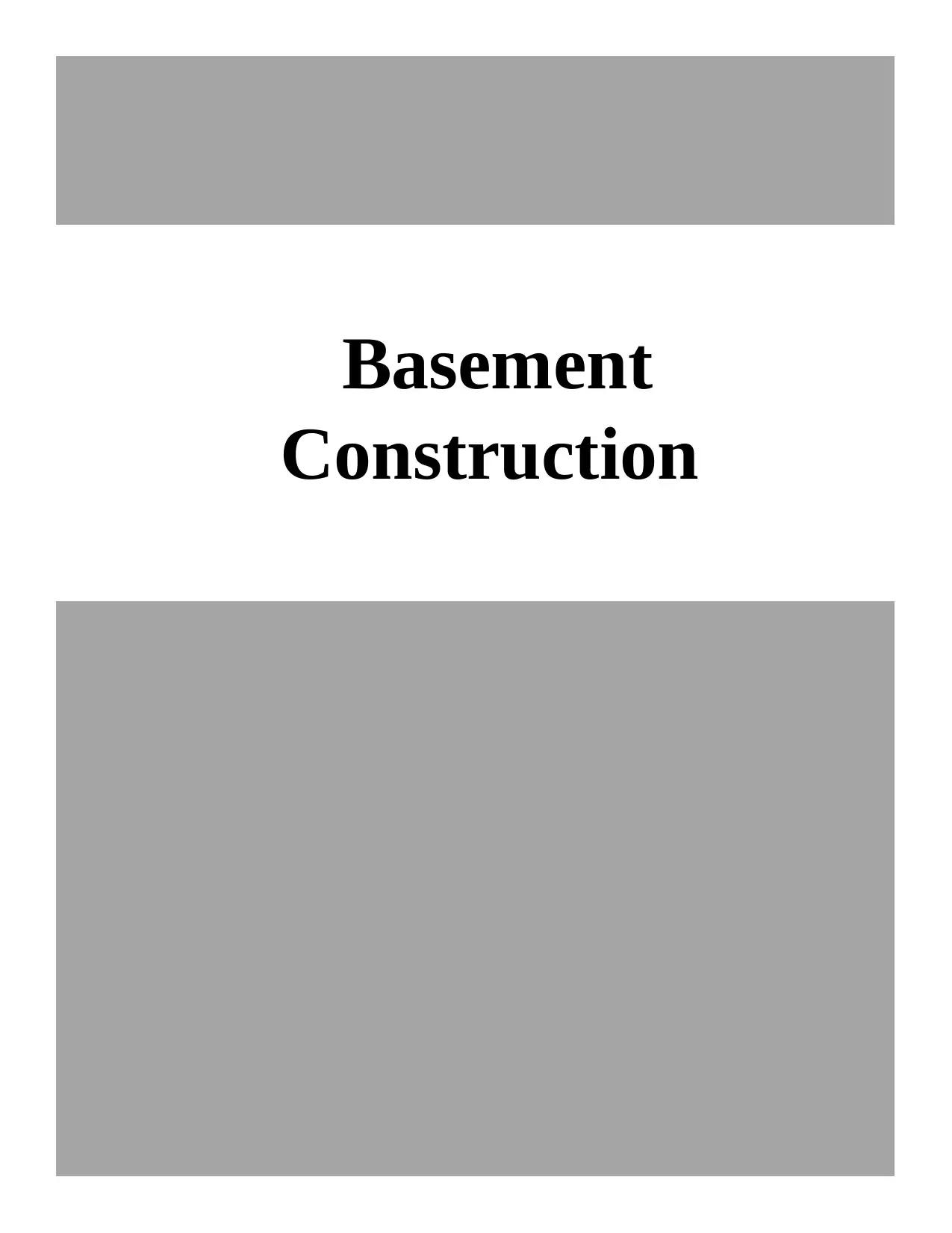
Construction
Basement
Basement
Paraphrase This Document
Need a fresh take? Get an instant paraphrase of this document with our AI Paraphraser
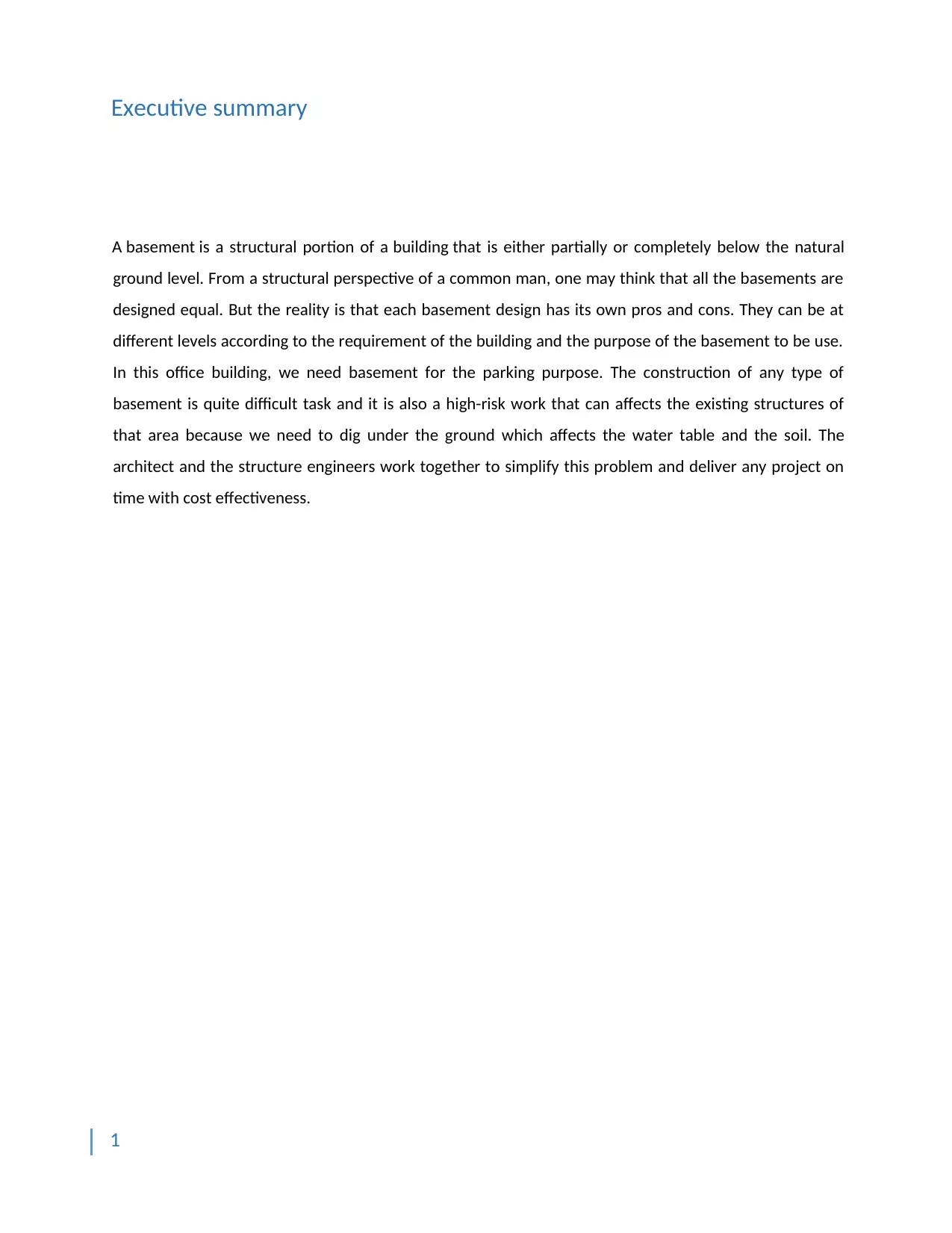
Executive summary
A basement is a structural portion of a building that is either partially or completely below the natural
ground level. From a structural perspective of a common man, one may think that all the basements are
designed equal. But the reality is that each basement design has its own pros and cons. They can be at
different levels according to the requirement of the building and the purpose of the basement to be use.
In this office building, we need basement for the parking purpose. The construction of any type of
basement is quite difficult task and it is also a high-risk work that can affects the existing structures of
that area because we need to dig under the ground which affects the water table and the soil. The
architect and the structure engineers work together to simplify this problem and deliver any project on
time with cost effectiveness.
1
A basement is a structural portion of a building that is either partially or completely below the natural
ground level. From a structural perspective of a common man, one may think that all the basements are
designed equal. But the reality is that each basement design has its own pros and cons. They can be at
different levels according to the requirement of the building and the purpose of the basement to be use.
In this office building, we need basement for the parking purpose. The construction of any type of
basement is quite difficult task and it is also a high-risk work that can affects the existing structures of
that area because we need to dig under the ground which affects the water table and the soil. The
architect and the structure engineers work together to simplify this problem and deliver any project on
time with cost effectiveness.
1

Introduction
The Government of New South Wales has launched a program named Newcastle Urban Transformation
and Transport Program Transport for NSW (TFNSW) is the main public transport agency of the
Government of NSW. The main purpose of this policy is to give and issues the policies regarding the all
the models and kind of transportation that will help the commoners to travel in the city. It also helps the
local bodies to plan and construct the roads to commute easily without any traffic related infrastructure
in NSW. The main reason why we are doing this project and making report about it is to present the
necessary technical information regarding the project like the construction of the building and the
techniques to be use for its construction. The main purpose of the said report is to present the design
and construction of structure of the most compatible basement foundation for the commercial retail
project. Transportation to NSW is responsible for improving the transportation customer experience
service, transportation policy and regulation, planning and administration of programs, transportation
and infrastructure services and freight. The Program has an objective to attract people back to the city
center by reinforcing connections between the waterfront and the city, providing job opportunities,
creating more public places and spaces, and developing better transport. The official governed body has
also announced the proper budget for the construction and management of the building and that is of
500 million dollars. The company wants to build an office with retail complex and the 1 level parking in
basement and for that purpose they acquire a land at Honeysuckle, Newcastle CBD.
2
The Government of New South Wales has launched a program named Newcastle Urban Transformation
and Transport Program Transport for NSW (TFNSW) is the main public transport agency of the
Government of NSW. The main purpose of this policy is to give and issues the policies regarding the all
the models and kind of transportation that will help the commoners to travel in the city. It also helps the
local bodies to plan and construct the roads to commute easily without any traffic related infrastructure
in NSW. The main reason why we are doing this project and making report about it is to present the
necessary technical information regarding the project like the construction of the building and the
techniques to be use for its construction. The main purpose of the said report is to present the design
and construction of structure of the most compatible basement foundation for the commercial retail
project. Transportation to NSW is responsible for improving the transportation customer experience
service, transportation policy and regulation, planning and administration of programs, transportation
and infrastructure services and freight. The Program has an objective to attract people back to the city
center by reinforcing connections between the waterfront and the city, providing job opportunities,
creating more public places and spaces, and developing better transport. The official governed body has
also announced the proper budget for the construction and management of the building and that is of
500 million dollars. The company wants to build an office with retail complex and the 1 level parking in
basement and for that purpose they acquire a land at Honeysuckle, Newcastle CBD.
2
⊘ This is a preview!⊘
Do you want full access?
Subscribe today to unlock all pages.

Trusted by 1+ million students worldwide
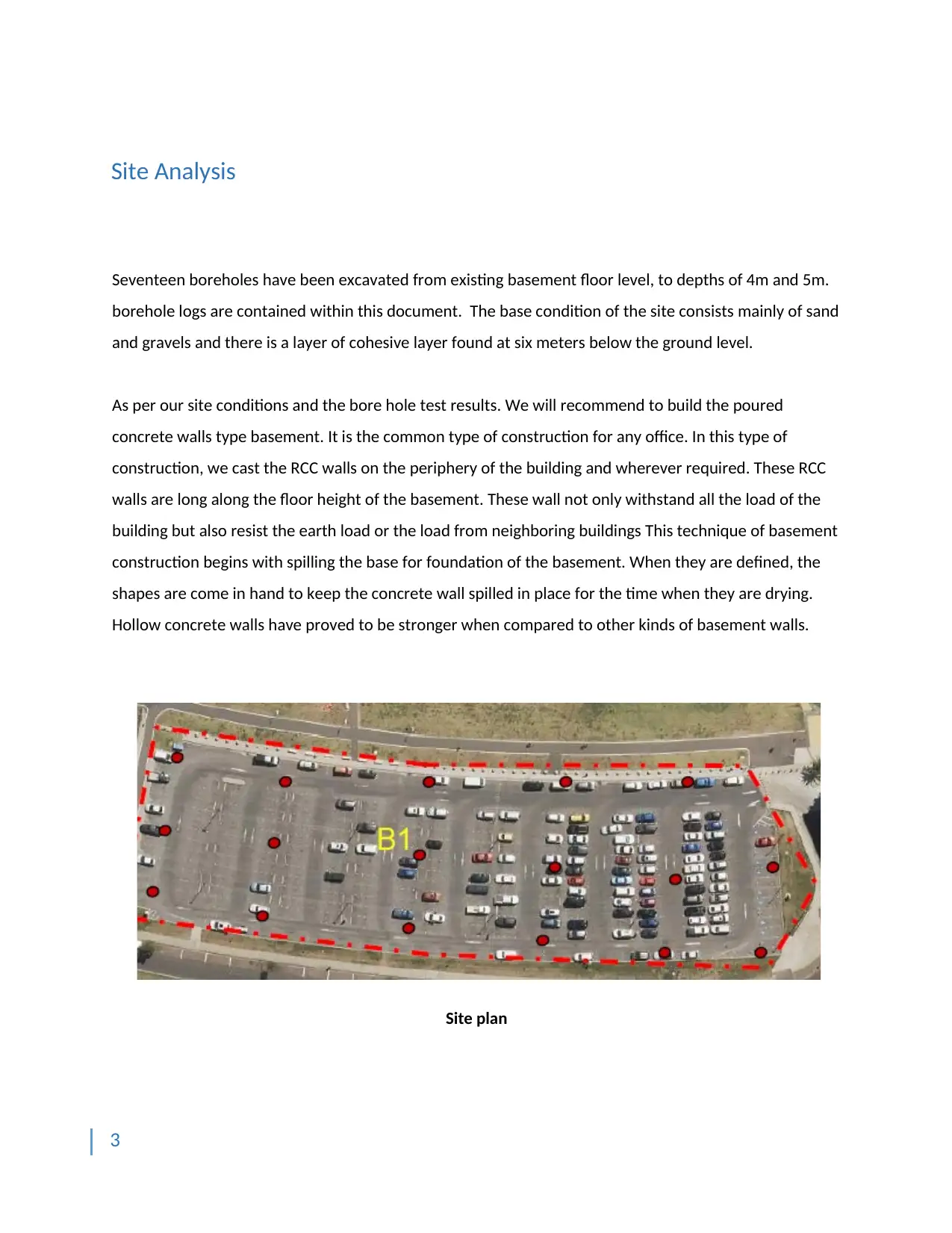
Site Analysis
Seventeen boreholes have been excavated from existing basement floor level, to depths of 4m and 5m.
borehole logs are contained within this document. The base condition of the site consists mainly of sand
and gravels and there is a layer of cohesive layer found at six meters below the ground level.
As per our site conditions and the bore hole test results. We will recommend to build the poured
concrete walls type basement. It is the common type of construction for any office. In this type of
construction, we cast the RCC walls on the periphery of the building and wherever required. These RCC
walls are long along the floor height of the basement. These wall not only withstand all the load of the
building but also resist the earth load or the load from neighboring buildings This technique of basement
construction begins with spilling the base for foundation of the basement. When they are defined, the
shapes are come in hand to keep the concrete wall spilled in place for the time when they are drying.
Hollow concrete walls have proved to be stronger when compared to other kinds of basement walls.
Site plan
3
Seventeen boreholes have been excavated from existing basement floor level, to depths of 4m and 5m.
borehole logs are contained within this document. The base condition of the site consists mainly of sand
and gravels and there is a layer of cohesive layer found at six meters below the ground level.
As per our site conditions and the bore hole test results. We will recommend to build the poured
concrete walls type basement. It is the common type of construction for any office. In this type of
construction, we cast the RCC walls on the periphery of the building and wherever required. These RCC
walls are long along the floor height of the basement. These wall not only withstand all the load of the
building but also resist the earth load or the load from neighboring buildings This technique of basement
construction begins with spilling the base for foundation of the basement. When they are defined, the
shapes are come in hand to keep the concrete wall spilled in place for the time when they are drying.
Hollow concrete walls have proved to be stronger when compared to other kinds of basement walls.
Site plan
3
Paraphrase This Document
Need a fresh take? Get an instant paraphrase of this document with our AI Paraphraser
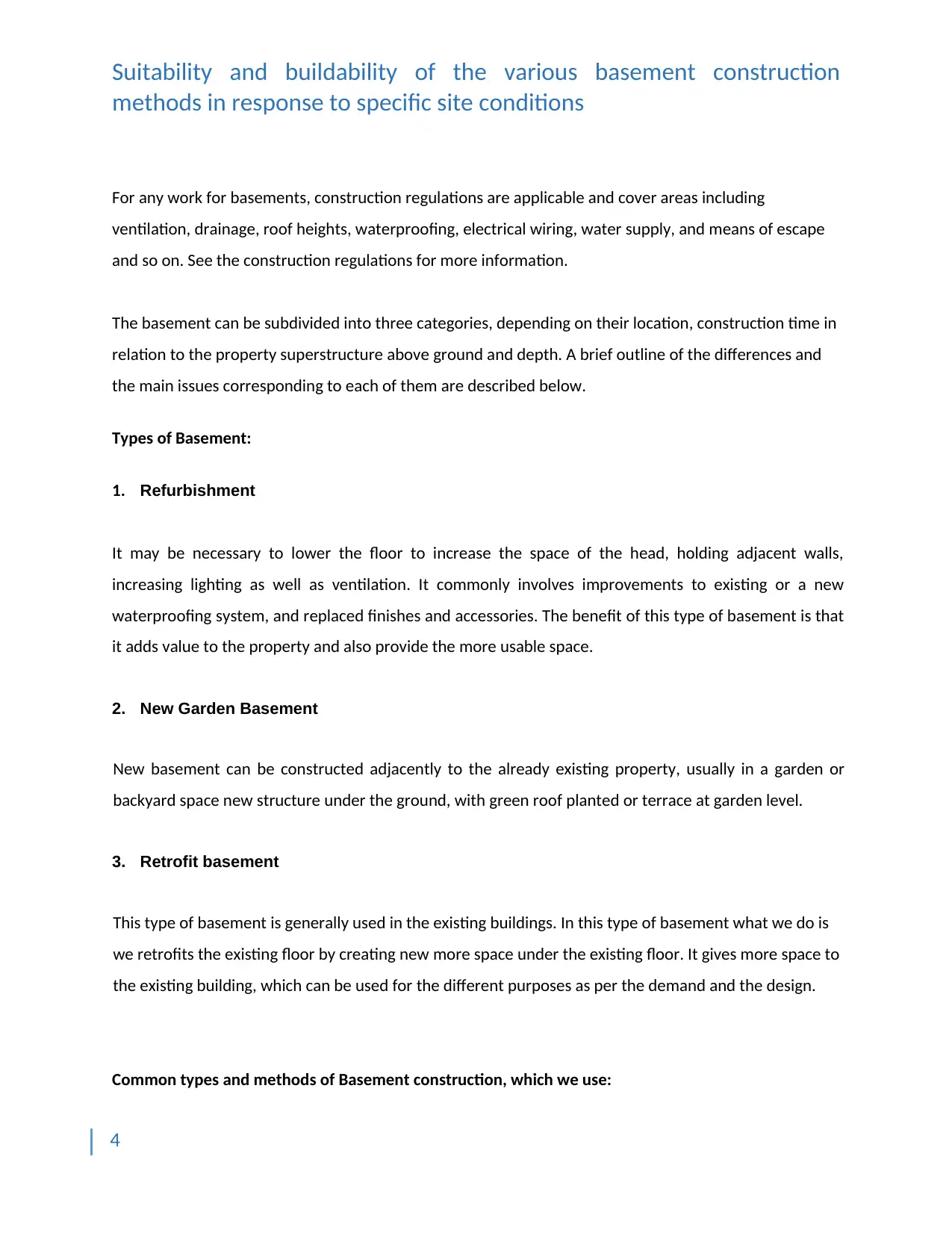
Suitability and buildability of the various basement construction
methods in response to specific site conditions
For any work for basements, construction regulations are applicable and cover areas including
ventilation, drainage, roof heights, waterproofing, electrical wiring, water supply, and means of escape
and so on. See the construction regulations for more information.
The basement can be subdivided into three categories, depending on their location, construction time in
relation to the property superstructure above ground and depth. A brief outline of the differences and
the main issues corresponding to each of them are described below.
Types of Basement:
1. Refurbishment
It may be necessary to lower the floor to increase the space of the head, holding adjacent walls,
increasing lighting as well as ventilation. It commonly involves improvements to existing or a new
waterproofing system, and replaced finishes and accessories. The benefit of this type of basement is that
it adds value to the property and also provide the more usable space.
2. New Garden Basement
New basement can be constructed adjacently to the already existing property, usually in a garden or
backyard space new structure under the ground, with green roof planted or terrace at garden level.
3. Retrofit basement
This type of basement is generally used in the existing buildings. In this type of basement what we do is
we retrofits the existing floor by creating new more space under the existing floor. It gives more space to
the existing building, which can be used for the different purposes as per the demand and the design.
Common types and methods of Basement construction, which we use:
4
methods in response to specific site conditions
For any work for basements, construction regulations are applicable and cover areas including
ventilation, drainage, roof heights, waterproofing, electrical wiring, water supply, and means of escape
and so on. See the construction regulations for more information.
The basement can be subdivided into three categories, depending on their location, construction time in
relation to the property superstructure above ground and depth. A brief outline of the differences and
the main issues corresponding to each of them are described below.
Types of Basement:
1. Refurbishment
It may be necessary to lower the floor to increase the space of the head, holding adjacent walls,
increasing lighting as well as ventilation. It commonly involves improvements to existing or a new
waterproofing system, and replaced finishes and accessories. The benefit of this type of basement is that
it adds value to the property and also provide the more usable space.
2. New Garden Basement
New basement can be constructed adjacently to the already existing property, usually in a garden or
backyard space new structure under the ground, with green roof planted or terrace at garden level.
3. Retrofit basement
This type of basement is generally used in the existing buildings. In this type of basement what we do is
we retrofits the existing floor by creating new more space under the existing floor. It gives more space to
the existing building, which can be used for the different purposes as per the demand and the design.
Common types and methods of Basement construction, which we use:
4
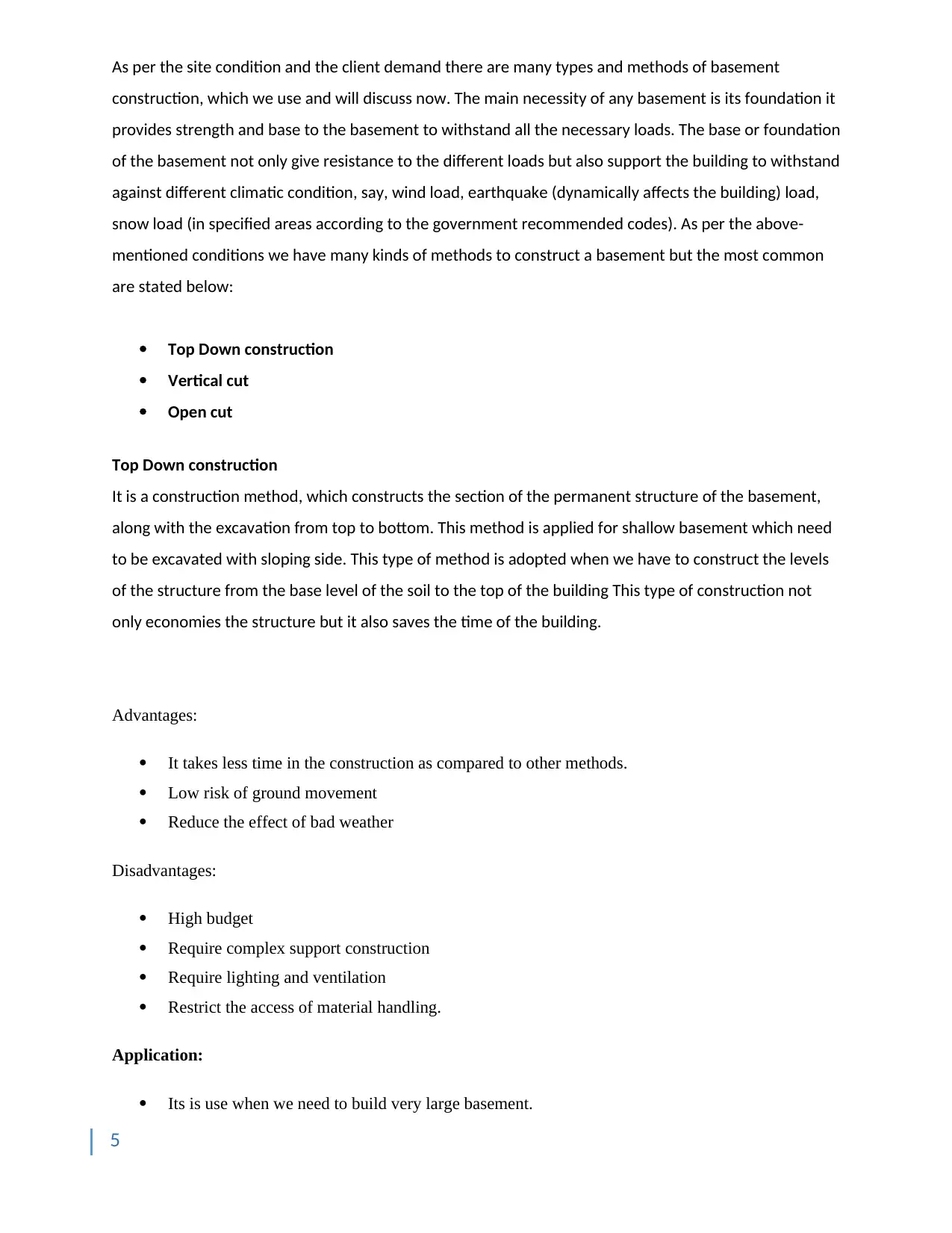
As per the site condition and the client demand there are many types and methods of basement
construction, which we use and will discuss now. The main necessity of any basement is its foundation it
provides strength and base to the basement to withstand all the necessary loads. The base or foundation
of the basement not only give resistance to the different loads but also support the building to withstand
against different climatic condition, say, wind load, earthquake (dynamically affects the building) load,
snow load (in specified areas according to the government recommended codes). As per the above-
mentioned conditions we have many kinds of methods to construct a basement but the most common
are stated below:
Top Down construction
Vertical cut
Open cut
Top Down construction
It is a construction method, which constructs the section of the permanent structure of the basement,
along with the excavation from top to bottom. This method is applied for shallow basement which need
to be excavated with sloping side. This type of method is adopted when we have to construct the levels
of the structure from the base level of the soil to the top of the building This type of construction not
only economies the structure but it also saves the time of the building.
Advantages:
It takes less time in the construction as compared to other methods.
Low risk of ground movement
Reduce the effect of bad weather
Disadvantages:
High budget
Require complex support construction
Require lighting and ventilation
Restrict the access of material handling.
Application:
Its is use when we need to build very large basement.
5
construction, which we use and will discuss now. The main necessity of any basement is its foundation it
provides strength and base to the basement to withstand all the necessary loads. The base or foundation
of the basement not only give resistance to the different loads but also support the building to withstand
against different climatic condition, say, wind load, earthquake (dynamically affects the building) load,
snow load (in specified areas according to the government recommended codes). As per the above-
mentioned conditions we have many kinds of methods to construct a basement but the most common
are stated below:
Top Down construction
Vertical cut
Open cut
Top Down construction
It is a construction method, which constructs the section of the permanent structure of the basement,
along with the excavation from top to bottom. This method is applied for shallow basement which need
to be excavated with sloping side. This type of method is adopted when we have to construct the levels
of the structure from the base level of the soil to the top of the building This type of construction not
only economies the structure but it also saves the time of the building.
Advantages:
It takes less time in the construction as compared to other methods.
Low risk of ground movement
Reduce the effect of bad weather
Disadvantages:
High budget
Require complex support construction
Require lighting and ventilation
Restrict the access of material handling.
Application:
Its is use when we need to build very large basement.
5
⊘ This is a preview!⊘
Do you want full access?
Subscribe today to unlock all pages.

Trusted by 1+ million students worldwide
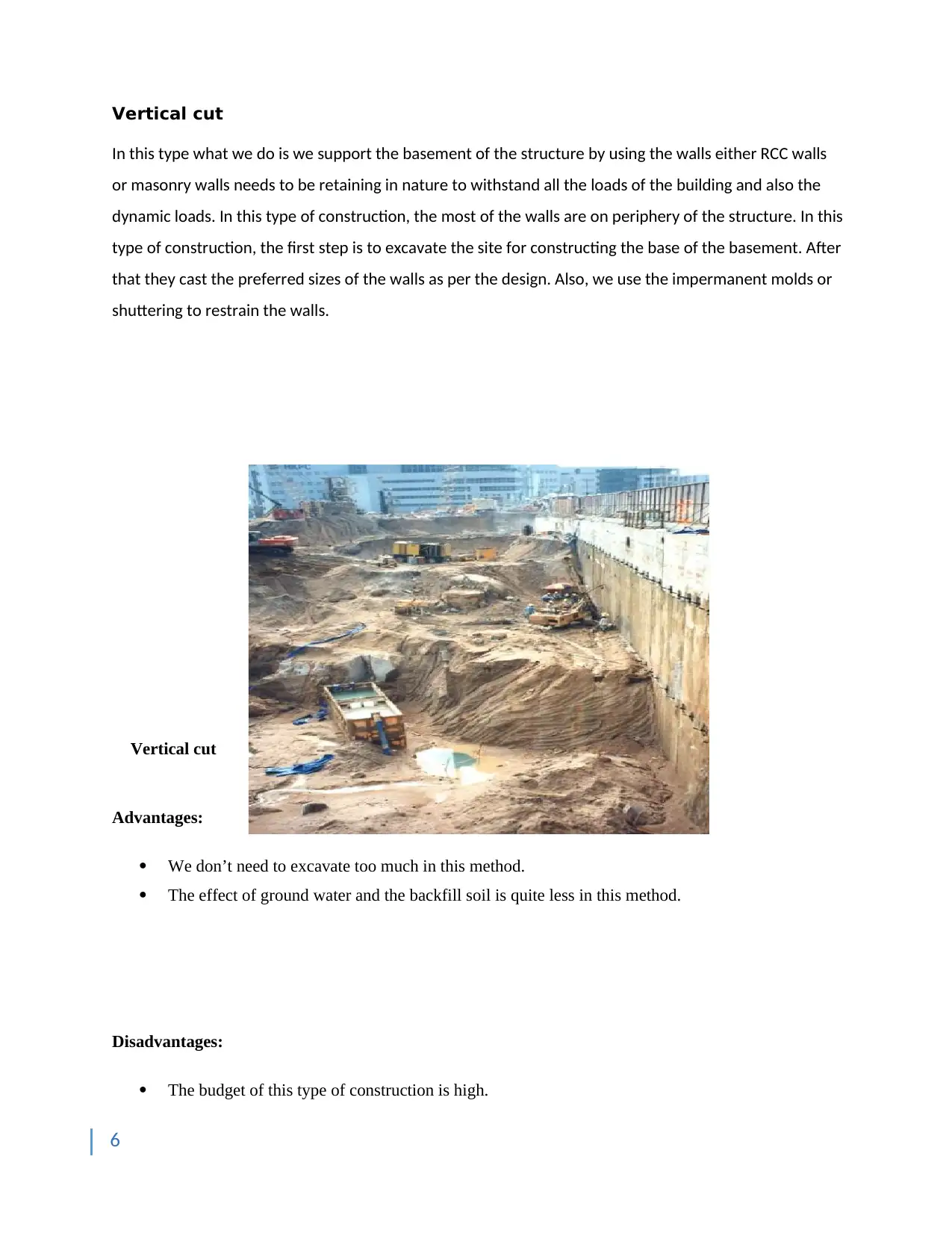
Vertical cut
In this type what we do is we support the basement of the structure by using the walls either RCC walls
or masonry walls needs to be retaining in nature to withstand all the loads of the building and also the
dynamic loads. In this type of construction, the most of the walls are on periphery of the structure. In this
type of construction, the first step is to excavate the site for constructing the base of the basement. After
that they cast the preferred sizes of the walls as per the design. Also, we use the impermanent molds or
shuttering to restrain the walls.
Vertical cut
Advantages:
We don’t need to excavate too much in this method.
The effect of ground water and the backfill soil is quite less in this method.
Disadvantages:
The budget of this type of construction is high.
6
In this type what we do is we support the basement of the structure by using the walls either RCC walls
or masonry walls needs to be retaining in nature to withstand all the loads of the building and also the
dynamic loads. In this type of construction, the most of the walls are on periphery of the structure. In this
type of construction, the first step is to excavate the site for constructing the base of the basement. After
that they cast the preferred sizes of the walls as per the design. Also, we use the impermanent molds or
shuttering to restrain the walls.
Vertical cut
Advantages:
We don’t need to excavate too much in this method.
The effect of ground water and the backfill soil is quite less in this method.
Disadvantages:
The budget of this type of construction is high.
6
Paraphrase This Document
Need a fresh take? Get an instant paraphrase of this document with our AI Paraphraser
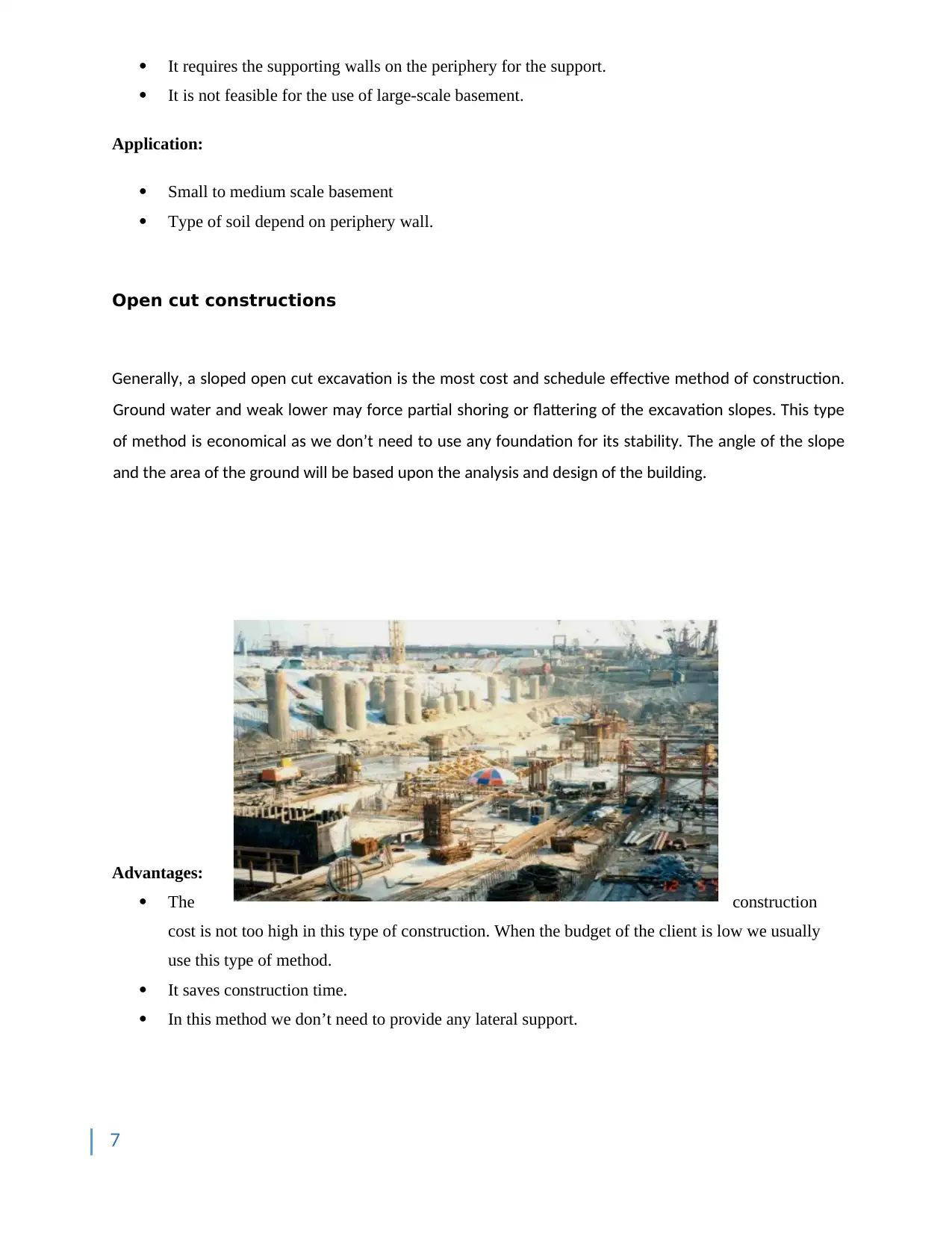
It requires the supporting walls on the periphery for the support.
It is not feasible for the use of large-scale basement.
Application:
Small to medium scale basement
Type of soil depend on periphery wall.
Open cut constructions
Generally, a sloped open cut excavation is the most cost and schedule effective method of construction.
Ground water and weak lower may force partial shoring or flattering of the excavation slopes. This type
of method is economical as we don’t need to use any foundation for its stability. The angle of the slope
and the area of the ground will be based upon the analysis and design of the building.
Advantages:
The construction
cost is not too high in this type of construction. When the budget of the client is low we usually
use this type of method.
It saves construction time.
In this method we don’t need to provide any lateral support.
7
It is not feasible for the use of large-scale basement.
Application:
Small to medium scale basement
Type of soil depend on periphery wall.
Open cut constructions
Generally, a sloped open cut excavation is the most cost and schedule effective method of construction.
Ground water and weak lower may force partial shoring or flattering of the excavation slopes. This type
of method is economical as we don’t need to use any foundation for its stability. The angle of the slope
and the area of the ground will be based upon the analysis and design of the building.
Advantages:
The construction
cost is not too high in this type of construction. When the budget of the client is low we usually
use this type of method.
It saves construction time.
In this method we don’t need to provide any lateral support.
7
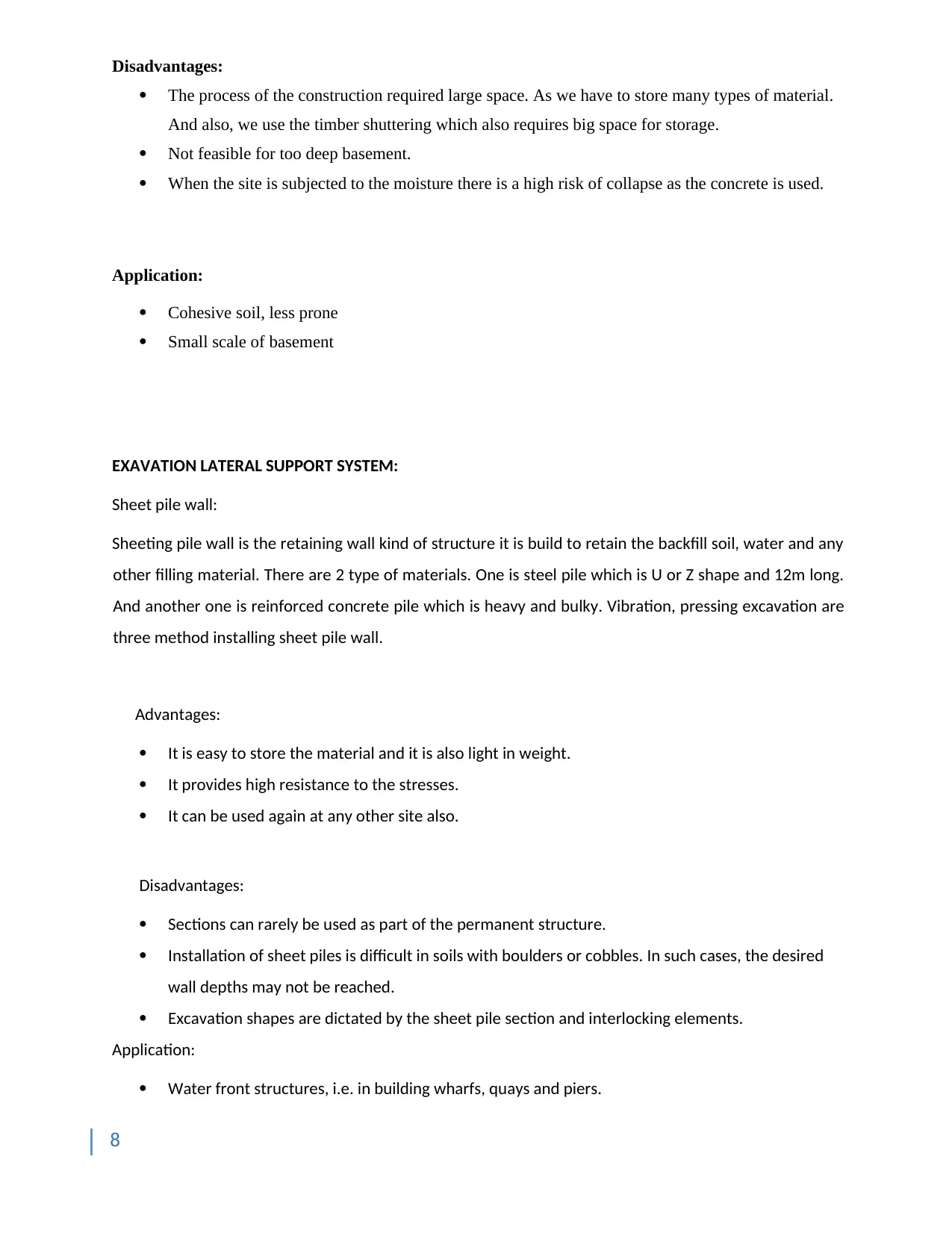
Disadvantages:
The process of the construction required large space. As we have to store many types of material.
And also, we use the timber shuttering which also requires big space for storage.
Not feasible for too deep basement.
When the site is subjected to the moisture there is a high risk of collapse as the concrete is used.
Application:
Cohesive soil, less prone
Small scale of basement
EXAVATION LATERAL SUPPORT SYSTEM:
Sheet pile wall:
Sheeting pile wall is the retaining wall kind of structure it is build to retain the backfill soil, water and any
other filling material. There are 2 type of materials. One is steel pile which is U or Z shape and 12m long.
And another one is reinforced concrete pile which is heavy and bulky. Vibration, pressing excavation are
three method installing sheet pile wall.
Advantages:
It is easy to store the material and it is also light in weight.
It provides high resistance to the stresses.
It can be used again at any other site also.
Disadvantages:
Sections can rarely be used as part of the permanent structure.
Installation of sheet piles is difficult in soils with boulders or cobbles. In such cases, the desired
wall depths may not be reached.
Excavation shapes are dictated by the sheet pile section and interlocking elements.
Application:
Water front structures, i.e. in building wharfs, quays and piers.
8
The process of the construction required large space. As we have to store many types of material.
And also, we use the timber shuttering which also requires big space for storage.
Not feasible for too deep basement.
When the site is subjected to the moisture there is a high risk of collapse as the concrete is used.
Application:
Cohesive soil, less prone
Small scale of basement
EXAVATION LATERAL SUPPORT SYSTEM:
Sheet pile wall:
Sheeting pile wall is the retaining wall kind of structure it is build to retain the backfill soil, water and any
other filling material. There are 2 type of materials. One is steel pile which is U or Z shape and 12m long.
And another one is reinforced concrete pile which is heavy and bulky. Vibration, pressing excavation are
three method installing sheet pile wall.
Advantages:
It is easy to store the material and it is also light in weight.
It provides high resistance to the stresses.
It can be used again at any other site also.
Disadvantages:
Sections can rarely be used as part of the permanent structure.
Installation of sheet piles is difficult in soils with boulders or cobbles. In such cases, the desired
wall depths may not be reached.
Excavation shapes are dictated by the sheet pile section and interlocking elements.
Application:
Water front structures, i.e. in building wharfs, quays and piers.
8
⊘ This is a preview!⊘
Do you want full access?
Subscribe today to unlock all pages.

Trusted by 1+ million students worldwide
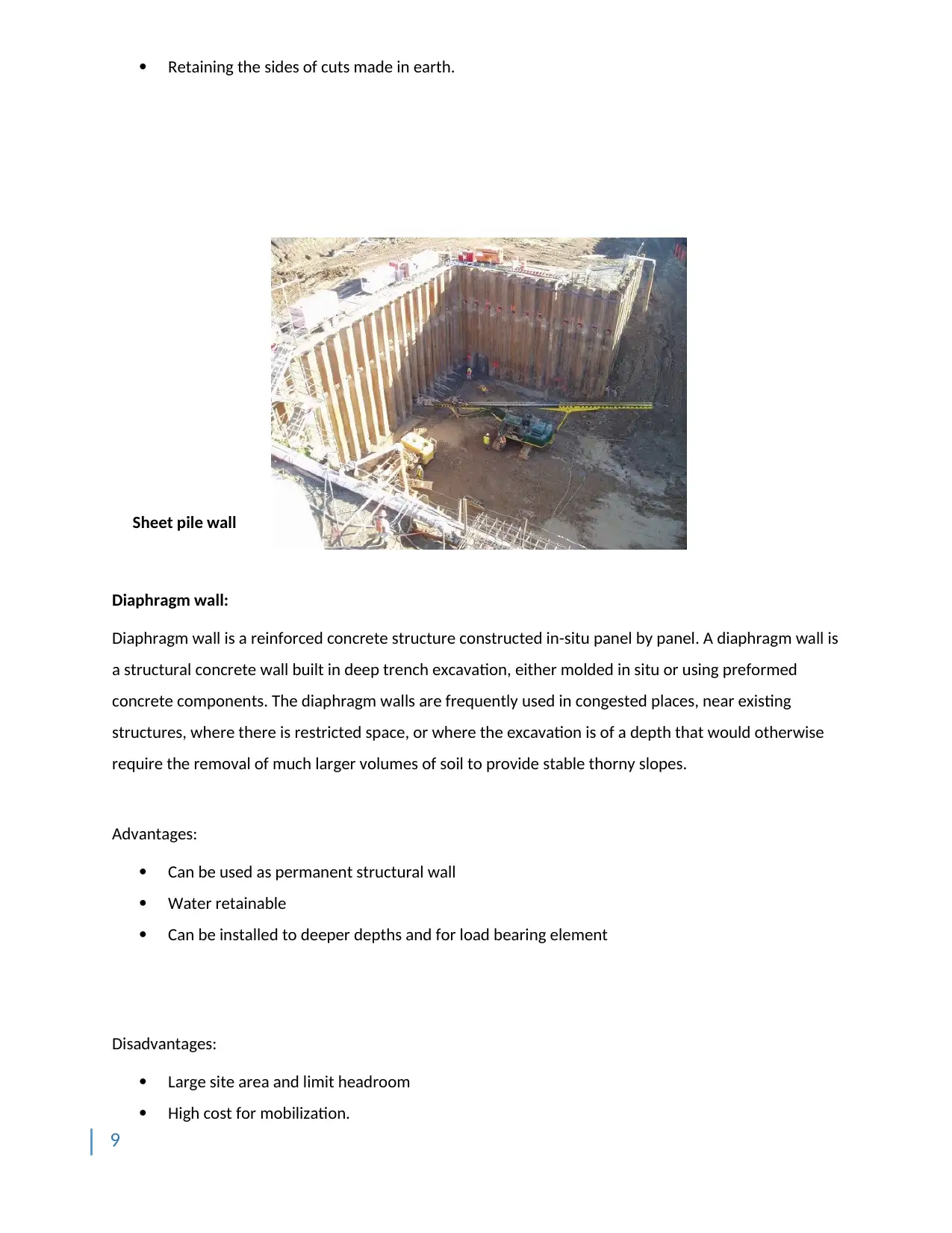
Retaining the sides of cuts made in earth.
Sheet pile wall
Diaphragm wall:
Diaphragm wall is a reinforced concrete structure constructed in-situ panel by panel. A diaphragm wall is
a structural concrete wall built in deep trench excavation, either molded in situ or using preformed
concrete components. The diaphragm walls are frequently used in congested places, near existing
structures, where there is restricted space, or where the excavation is of a depth that would otherwise
require the removal of much larger volumes of soil to provide stable thorny slopes.
Advantages:
Can be used as permanent structural wall
Water retainable
Can be installed to deeper depths and for load bearing element
Disadvantages:
Large site area and limit headroom
High cost for mobilization.
9
Sheet pile wall
Diaphragm wall:
Diaphragm wall is a reinforced concrete structure constructed in-situ panel by panel. A diaphragm wall is
a structural concrete wall built in deep trench excavation, either molded in situ or using preformed
concrete components. The diaphragm walls are frequently used in congested places, near existing
structures, where there is restricted space, or where the excavation is of a depth that would otherwise
require the removal of much larger volumes of soil to provide stable thorny slopes.
Advantages:
Can be used as permanent structural wall
Water retainable
Can be installed to deeper depths and for load bearing element
Disadvantages:
Large site area and limit headroom
High cost for mobilization.
9
Paraphrase This Document
Need a fresh take? Get an instant paraphrase of this document with our AI Paraphraser
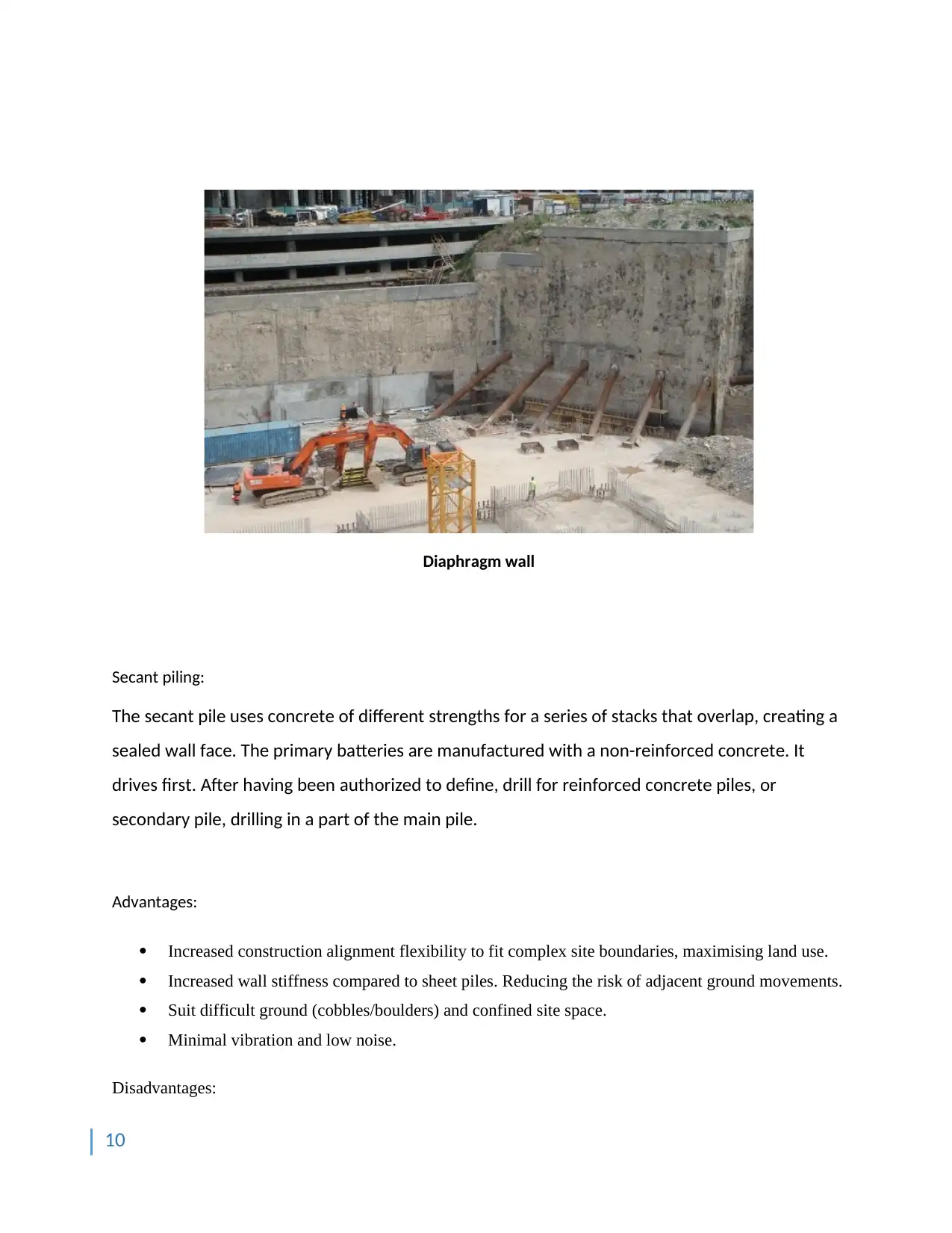
Diaphragm wall
Secant piling:
The secant pile uses concrete of different strengths for a series of stacks that overlap, creating a
sealed wall face. The primary batteries are manufactured with a non-reinforced concrete. It
drives first. After having been authorized to define, drill for reinforced concrete piles, or
secondary pile, drilling in a part of the main pile.
Advantages:
Increased construction alignment flexibility to fit complex site boundaries, maximising land use.
Increased wall stiffness compared to sheet piles. Reducing the risk of adjacent ground movements.
Suit difficult ground (cobbles/boulders) and confined site space.
Minimal vibration and low noise.
Disadvantages:
10
Secant piling:
The secant pile uses concrete of different strengths for a series of stacks that overlap, creating a
sealed wall face. The primary batteries are manufactured with a non-reinforced concrete. It
drives first. After having been authorized to define, drill for reinforced concrete piles, or
secondary pile, drilling in a part of the main pile.
Advantages:
Increased construction alignment flexibility to fit complex site boundaries, maximising land use.
Increased wall stiffness compared to sheet piles. Reducing the risk of adjacent ground movements.
Suit difficult ground (cobbles/boulders) and confined site space.
Minimal vibration and low noise.
Disadvantages:
10
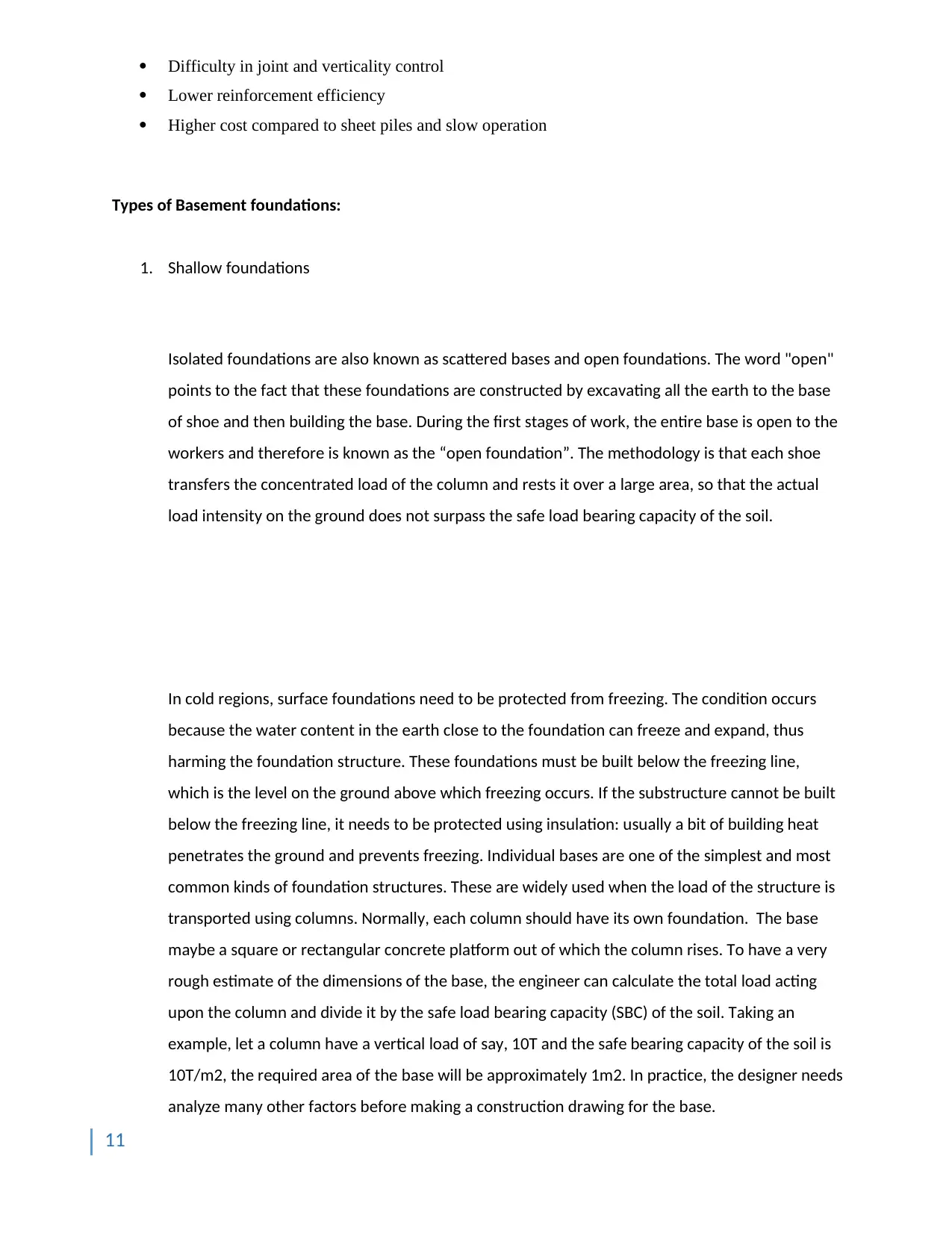
Difficulty in joint and verticality control
Lower reinforcement efficiency
Higher cost compared to sheet piles and slow operation
Types of Basement foundations:
1. Shallow foundations
Isolated foundations are also known as scattered bases and open foundations. The word "open"
points to the fact that these foundations are constructed by excavating all the earth to the base
of shoe and then building the base. During the first stages of work, the entire base is open to the
workers and therefore is known as the “open foundation”. The methodology is that each shoe
transfers the concentrated load of the column and rests it over a large area, so that the actual
load intensity on the ground does not surpass the safe load bearing capacity of the soil.
In cold regions, surface foundations need to be protected from freezing. The condition occurs
because the water content in the earth close to the foundation can freeze and expand, thus
harming the foundation structure. These foundations must be built below the freezing line,
which is the level on the ground above which freezing occurs. If the substructure cannot be built
below the freezing line, it needs to be protected using insulation: usually a bit of building heat
penetrates the ground and prevents freezing. Individual bases are one of the simplest and most
common kinds of foundation structures. These are widely used when the load of the structure is
transported using columns. Normally, each column should have its own foundation. The base
maybe a square or rectangular concrete platform out of which the column rises. To have a very
rough estimate of the dimensions of the base, the engineer can calculate the total load acting
upon the column and divide it by the safe load bearing capacity (SBC) of the soil. Taking an
example, let a column have a vertical load of say, 10T and the safe bearing capacity of the soil is
10T/m2, the required area of the base will be approximately 1m2. In practice, the designer needs
analyze many other factors before making a construction drawing for the base.
11
Lower reinforcement efficiency
Higher cost compared to sheet piles and slow operation
Types of Basement foundations:
1. Shallow foundations
Isolated foundations are also known as scattered bases and open foundations. The word "open"
points to the fact that these foundations are constructed by excavating all the earth to the base
of shoe and then building the base. During the first stages of work, the entire base is open to the
workers and therefore is known as the “open foundation”. The methodology is that each shoe
transfers the concentrated load of the column and rests it over a large area, so that the actual
load intensity on the ground does not surpass the safe load bearing capacity of the soil.
In cold regions, surface foundations need to be protected from freezing. The condition occurs
because the water content in the earth close to the foundation can freeze and expand, thus
harming the foundation structure. These foundations must be built below the freezing line,
which is the level on the ground above which freezing occurs. If the substructure cannot be built
below the freezing line, it needs to be protected using insulation: usually a bit of building heat
penetrates the ground and prevents freezing. Individual bases are one of the simplest and most
common kinds of foundation structures. These are widely used when the load of the structure is
transported using columns. Normally, each column should have its own foundation. The base
maybe a square or rectangular concrete platform out of which the column rises. To have a very
rough estimate of the dimensions of the base, the engineer can calculate the total load acting
upon the column and divide it by the safe load bearing capacity (SBC) of the soil. Taking an
example, let a column have a vertical load of say, 10T and the safe bearing capacity of the soil is
10T/m2, the required area of the base will be approximately 1m2. In practice, the designer needs
analyze many other factors before making a construction drawing for the base.
11
⊘ This is a preview!⊘
Do you want full access?
Subscribe today to unlock all pages.

Trusted by 1+ million students worldwide
1 out of 22
Related Documents
Your All-in-One AI-Powered Toolkit for Academic Success.
+13062052269
info@desklib.com
Available 24*7 on WhatsApp / Email
![[object Object]](/_next/static/media/star-bottom.7253800d.svg)
Unlock your academic potential
Copyright © 2020–2025 A2Z Services. All Rights Reserved. Developed and managed by ZUCOL.





